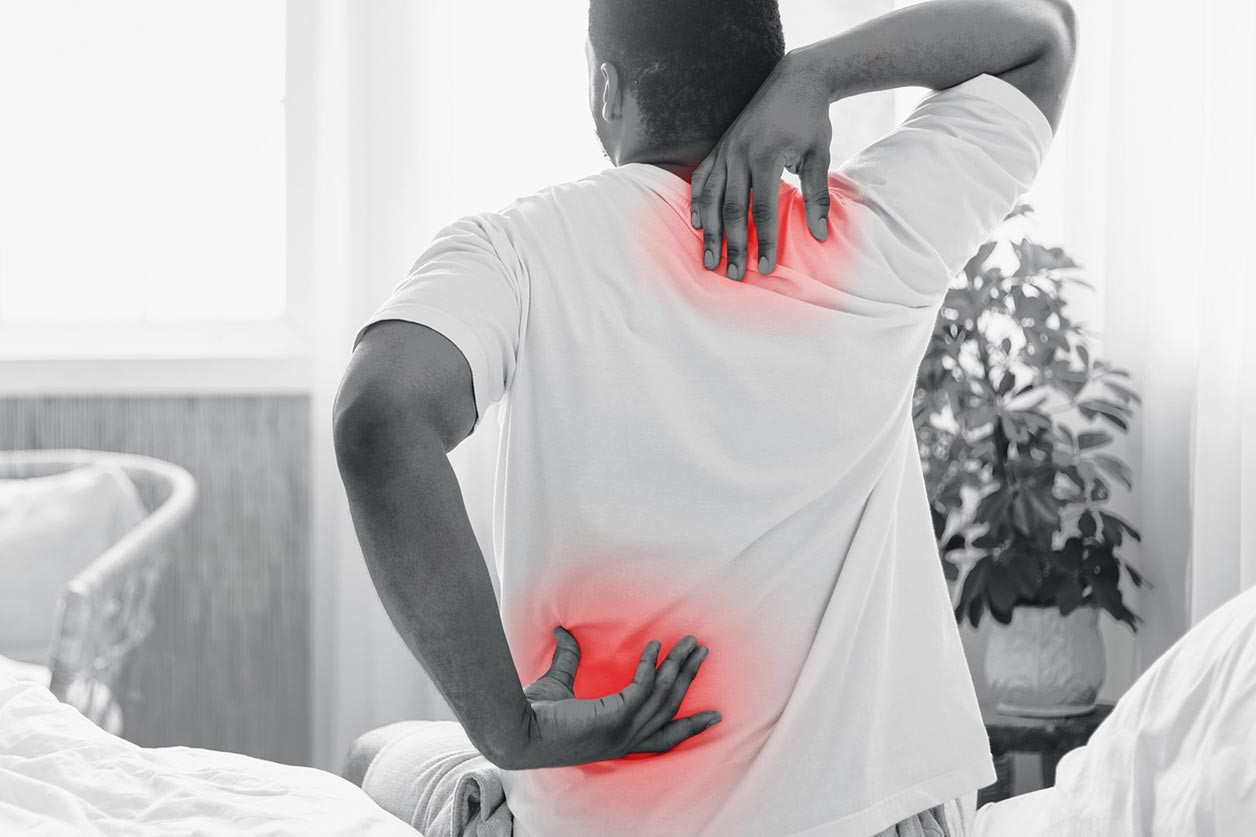
Back pain, what are the different types
When it comes to our backs, there are many different types of back pain. It is also a common reason for absence from work for many of us and for seeking medical treatment
Back pain can be debilitating which can be caused as a result of injury, activity, and some medical conditions
Back pain can affect people of any age, although as people get older, the chance of developing lower back pain increases, due to factors such as previous occupation and degenerative disc disease.
The first step towards back pain is diagnosing the cause.
Please read our common back pain symptoms checker as follows, to help you understand your pain and see what it could mean for you:
Symptom #1: Severe neck pain, with difficulty turning neck from one side to another
Everyone experiences neck pain or stiffness occasionally.
In many cases, it’s due to poor posture or overuse of one position of the muscles.
Sometimes, this kind of pain is caused by injury from a fall or sports.
Neck pain isn’t a serious condition and can be relieved within a few days automatically.
However, in some cases, it can indicate serious injury or illness and require a doctor’s care, especially when the pain continues for more than a week or is severe.
What it could be: Meningitis, cancer, or sign of Rheumatoid Arthritis
Increasing age most often causes such pain, although one does not have to be elderly to have it.
How it’s treated: Treatment for neck pain purely depends on the diagnosis done by a physical examination through your doctor.
To treat chronic neck pain, your doctor may prescribe medicine to relax the neck muscles or prescribe medicines to relieve pain which might help in resting or sleeping.
Surgery is rarely done to treat neck pain, but it can be performed if the pain is caused by a medical problem, such as pressure on the spinal nerve roots, a tumor, or a narrowing of the spinal canal.
Symptom #2: Severe leg pain that extends down to the back
In this situation, you can experience a pain that originates in the lower back but is much worse in the legs further.
Sufferers of this condition might even face trouble in standing and typically feel better when lying down.
What it could be: Sciatica
Often the result of a herniated disc, sciatica is a form of pain that radiates along the sciatic nerve.
Your sciatic nerve extends from the lower back, through your hips until down the legs.
Typically such pain occurs on one side of your body.
How it’s treated: Most people with sciatica get better in a few weeks with physical therapy, which develops a stretching and exercise routine for you, and also help improve your posture to take the pressure off the sciatic nerve along with medicines. (WebMD, 2019)
Symptom #3: Chronic lower back pain
The lower back is the area of the back that starts below the ribcage.
Almost everyone has low back pain at some point in life and unfortunately one of the top causes of missed work in the U.S.
This pain gets worse and worse over time, especially when standing for long periods.
What it could be: Spinal Stenosis
Spinal Stenosis is the narrowing of the spaces in your spine, which results in severe pain.
Natural aging is the main culprit, but genetics, such as being born with a smaller canal or an inherited disorder, and poor posture can also lead to this.
How it’s treated: Self-care treatments, such as medications or physical therapy, are best-prescribed things for Spinal Stenosis.
Although, there are a few surgical options available as well for the same.
Symptom #4: A radiating pain in the neck with decreased mobility
Back pain can occur anytime when you least expect it.
One minute you’re sitting comfortably on the couch and the next you try to stand up, and — ouch! — a sharp pain radiates through your lower back.
What it could be: Slipped Disc
Also called Spondylolisthesis, when a soft cushion of tissue between the bones in your spine pushes out. It’s painful if it presses on nerves but is treatable gradually.
How it’s treated: Most people with a slipped disc are offered “conservative” treatment, meaning that the treatment does not involve surgery.
This mainly involves exercise, relaxation, and positioning along with painkillers or local anesthetics.
(Spine Universe, 2020)
When to visit the ER
Sudden intense back pain is a big reason for patients to visit the emergency room, especially after a fall or a car accident.
You know you.
If your pain is unmanageable, limiting your mobility or increasing over time after some home remedies such as taking an NSAID or using heat or cold on the pain, it’s time for a diagnosis.
References
“Back Injuries: How To Manage Pain for Different Types.” WebMD, WebMD, 23 Oct. 2019, www.webmd.com/back-pain/guide/pain-management-back-pain#1
“Low Back Pain.” AANS, www.aans.org/en/Patients/Neurosurgical-Conditions-and-Treatments/Low-Back-Pain
Written by Dawn Ferchak; Reviewed by Joshua T. Wewel, MD. “What Hurts? 3 Types of Back Pain.” SpineUniverse, 2020, www.spineuniverse.com/conditions/back-pain/what-hurts-types-back-pain
Read Also
Emergency Live Even More…Live: Download The New Free App Of Your Newspaper For IOS And Android
Back Pain: Is It Really A Medical Emergency?
Kidney Stones: Types, Symptoms And Treatment
What To Know About The Neck Trauma In Emergency? Basics, Signs And Treatments
Lumbago: What It Is And How To Treat It
Back Pain: The Importance Of Postural Rehabilitation
Cervicalgia: Why Do We Have Neck Pain?
O.Therapy: What It Is, How It Works And For Which Diseases It Is Indicated
Oxygen-Ozone Therapy In The Treatment Of Fibromyalgia
Hyperbaric Oxygen In The Wound Healing Process
Oxygen-Ozone Therapy, A New Frontier In The Treatment Of Knee Arthrosis
Assessment Of Neck And Back Pain In The Patient
‘Gendered’ Back Pain: The Differences Between Men And Women
The Causes Of Acute Low Back Pain


